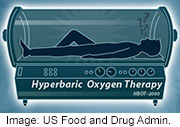
THURSDAY, Aug. 22 (HealthDay News) — Despite claims on some websites, there is no evidence that hyperbaric oxygen therapy cures or is an effective treatment for diseases such as cancer, autism, diabetes or other diseases, the U.S. Food and Drug Administration says.
Hyperbaric oxygen therapy is approved by the FDA for certain medical uses, including treating decompression sickness suffered by divers, carbon monoxide poisoning and burns caused by heat or fire.
But claims made by some treatment centers that hyperbaric oxygen therapy can help with a wide range of health issues are misleading and may put people’s health at risk, according to the FDA.
“Patients may incorrectly believe that these devices have been proven safe and effective for uses not cleared by the FDA, which may cause them to delay or forgo proven medical therapies,” Nayan Patel, a biomedical engineer in the FDA’s anesthesiology devices branch, said Thursday in an agency news release. “In doing so, they may experience a lack of improvement and/or worsening of their existing conditions.”
The safety and effectiveness of hyperbaric oxygen therapy has not been established for the following diseases and conditions: HIV/AIDS, Alzheimer’s disease, asthma, Bell’s palsy, brain injuries, cerebral palsy, depression, heart disease, hepatitis, migraines, multiple sclerosis, Parkinson’s disease, spinal cord injuries, sports injuries and stroke.
The FDA has received 27 complaints from consumers and health care professionals over the past three years about treatment centers promoting the hyperbaric chamber for uses not approved by the agency, Patel said.
Hyperbaric therapy involves breathing oxygen in a pressurized chamber where atmospheric pressure is raised up to three times higher than normal. In this way, the lungs can gather up to three times more oxygen than possible by breathing oxygen at normal air pressure.
The therapy increases the amount of oxygen dissolved in the blood, and an increase in blood oxygen helps tissues fight infection or recover from injury, Patel said.
Patients receiving hyperbaric oxygen therapy, however, are at risk of mild injuries, such as sinus pain, ear pressure and painful joints, or serious problems, such as paralysis and air embolisms, which are dangerous bubbles in the bloodstream that obstruct circulation. Since hyperbaric chambers are oxygen-rich environments, a risk of fire also exists.
“If you’re considering using [hyperbaric oxygen therapy], it’s essential that you first discuss all possible options with your health care professional,” Patel said. “Whatever treatment you’re getting, you need to understand its benefits and risks. Your health care professional can help you determine which treatment is your best option.”
More information
The U.S. National Library of Medicine has more about hyperbaric oxygen therapy.
Copyright © 2025 HealthDay. All rights reserved.

